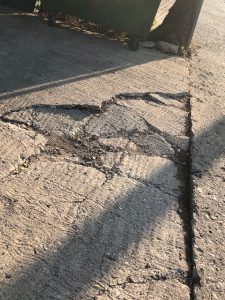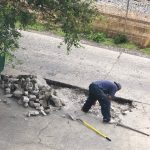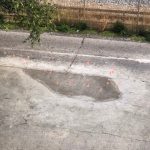 A couple years ago, I noticed a narrow crooked line along the back of the parking pad behind my building. Like the course of a river etched in a map (map, remember those?), this line zigged and zagged and seemed to run around different, unseen, objects.
A couple years ago, I noticed a narrow crooked line along the back of the parking pad behind my building. Like the course of a river etched in a map (map, remember those?), this line zigged and zagged and seemed to run around different, unseen, objects.
It was a crack in the cement. It wasn’t very deep. It looked harmless.
The next year, I noticed the crack growing longer and deeper. It was behind where I parked my car, close to the alley, not far from the dumpster.
During the winter, when the crater filled with water and turned into ice, I got in the habit of praying that I wouldn’t have to accelerate my car over this patch in order to maneuver into my space. I was afraid I’d end up hitting the SUV parked just to my left.
I never hit my neighbor’s car, but, trying to avoid this contact, I swiped the passenger side of my gray Toyota against the dumpster, leaving a green streak.
When spring came, I could see that the crack was getting bigger.
Automatically, it seemed, I started looking for someone to blame. For months, I quietly stewed over the weight of families who parked two vehicles in their lane. I assumed that caused the problem.
The man who lives in the unit across from mine pointed out that the property just to our east has a big tree near the alley. He believed the tree’s roots stretched out under our parking area, causing fissures and buckles in the surface.
Now, this was getting complicated. Would the owner next door cut down his tree? I wondered if the other condo owners in my building cared about the issue. At this point, It mostly just affected me.
And the crack grew. Over two years, it grew to the point that I dreaded parking, even in good weather.
It was hard for me to speak up to my building neighbors and ask for our community to pay for the repairs as it mostly impacted me, but eventually, I did.
It was difficult for our board to find a contractor that would do such a small job. The ones we talked to wanted to re-surface the whole thing for an amount our building owners were not ready to spend.
As I’ve been giving more time to contemplating societal struggles and personal growth lately, I know I’ve written several posts about perspectives on repairing or healing things.
Key preoccupations have centered around getting to the root cause of different situations or returning to old problems with more confidence in being able to make progress because I would be looking at them with fresh perspectives.
This episode on fixing the crack brought up a different insight. The work that needed to be done couldn’t be done by me or me alone.
I had to get approval from my neighbors to spend the money. We had to agree on a contractor to do the work. The man who parks next to me had to agree not to use the space for a few days.
At first, I was concerned that my building neighbors wouldn’t care about what seemed to be “my” problem, but I quickly came to a truer understanding.
What I pay in monthly assessments goes to support the integrity of the building. When I agreed to live in this building, as example, I understood some of my money might help pay for repairs on the window casements in 3-West, which prevents rain from seeping into THEIR home. This is what it means to be part of a community. I guess everyone in my building feels similarly.
I remember when Governor Cuomo gave regular press conferences as New York was the epicenter of the pandemic in the US. He recommended that the whole country help provide medical resources for them as they were urgently needed, understanding that people in New York would help other parts of the country when they had especially difficult outbreaks.
That’s what’s necessary to solve so many problems. It’s in everyone’s interest to take care of the basic needs of everyone; to offer help where it’s needed. That will put more people in a position to be able to help us when we have a need or when wide-ranging cooperation is needed.
Coming together with your neighbors to fix a crack is no small thing.


Another post, Remembering Names, about the simple joy of feeling like you matter within your circle or neighborhood appears in the collection, The Best of No Small Thing — Mindful Meditations. Click HERE to learn how you can buy the book.


Leave a comment